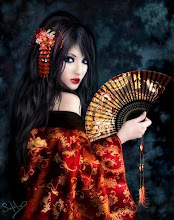Monday, March 9, 2009
Sunday, February 8, 2009
Characteristics of Japanese Design

1. Japanese design is spiritual , exuding a feeling of calm and peace.
2. It is movable and flexible, think of the shogi screens.
3. Minimalist, with forms that are never loud or trying to catch attention.
4. Simplicity is key, colors are muted not bright and often contrasted with black.
5. Japanese design is partial to harmony with nature.
6. Neatness, devoid of clutter.
7. Well made, of high quality.
8. Precision in its products and even martial arts.
9. Concept of balance between the old and new
10. Clean.
Lead Girl in Tokyo Drift


Just when I thought the female lead star, Nathalie Kelly, in The Fast and the Furious Tokyo Drift is one gorgeous Asian girl, a mini-bio of hers say she is Latina, particularly Peruvian and Argentine raised in Australia. Well, the tan and some eyeliner have done the trick. Kireii onna/beautiful girl.
Friday, February 6, 2009
Cherry Blossoms in DC: A Symbol of Amity
 Washington was not always as colorful and blooming with more than three thousand cherry blossom tress. The spectacular trees were almost not planted in 1912, thanks to the inspired action of a woman. Here's a little history on how the favorite tree of the Japanese got there.
Washington was not always as colorful and blooming with more than three thousand cherry blossom tress. The spectacular trees were almost not planted in 1912, thanks to the inspired action of a woman. Here's a little history on how the favorite tree of the Japanese got there.It all started with Eliza Scidmore's vision of transplanting the cherry blossoms from Japan in 1885. She was so infatuated with the striking beauty of the tress that she made it her life's mission to have them planted at the Patomac Waterfront. However, the idea was not considered significant enough by the government. After 24 years, Dr. David Fairchild an officer of the US Agriculture Department happened to have the same liking to the trees and ordered 100 from Yokohama Nursery for test planting on his own property. The trees survived the winter and bursted with color on spring. After the display of beauty, First Lady Helen Taft supported the cherry blossom project of Eliza. It was by luck or fate that Dr. Jokichi Takamine, a Japanese chemist visiting the US learned about the project of Eliza and pledged 2000 trees. As a symbol of friendship between the two countries, Japan made the trees its official gift to Washington, like that of France's Statue of Liberty in New York. The trees arrived in 1910 and just when Eliza thought she had fulfilled a dream, the US Customs declared them unfit to be planted in the Washington landscape since they were infested with insects and disease. President Taft ordered all of them burned. There was a question whether or not the trees were in fact infested. The Japanese nursery certified them even before leaving Japan. Would Japan ever give a rotten national gift? During those times, many locals of Washington did not welcome the idea of the 'invasion' of foreign trees.
Instead of being disheartened, Eliza and Dr. Takamine supplied another batch of three thousand trees. They finally arrived on 1912. The First Lady and the wife of a Japanese Ambassador planted the first two trees. Since then, the cherry blossoms bloomed and Washington was never the same again.
Sakura Fever

Spring (March to April) is just around the corner and to most, it is the best time to see Japan. It is the most picturesque of all seasons where the cherry blossoms are in full bloom. At these times, Japan is painted with pink and white. The beauty of the flowers are temporary, like any other beauty, they don't last forever. It takes only a week before they start to fall so the Japanese and tourists take the opportunity to go out in the parks to marvel at the sights to behold. This is called Hanami. In Japan, the sakura is a reminder that life is short, it is transient like the blossoms. Some good things never last.
Labels: traveling to japan
cherry blossoms,
Japanese spring festival,
spring in Japan
Subscribe to:
Comments (Atom)
